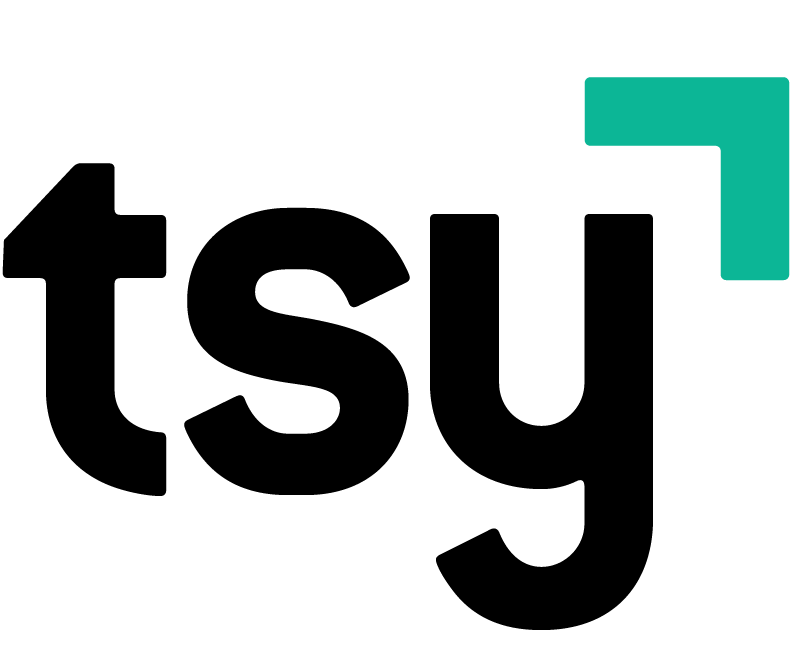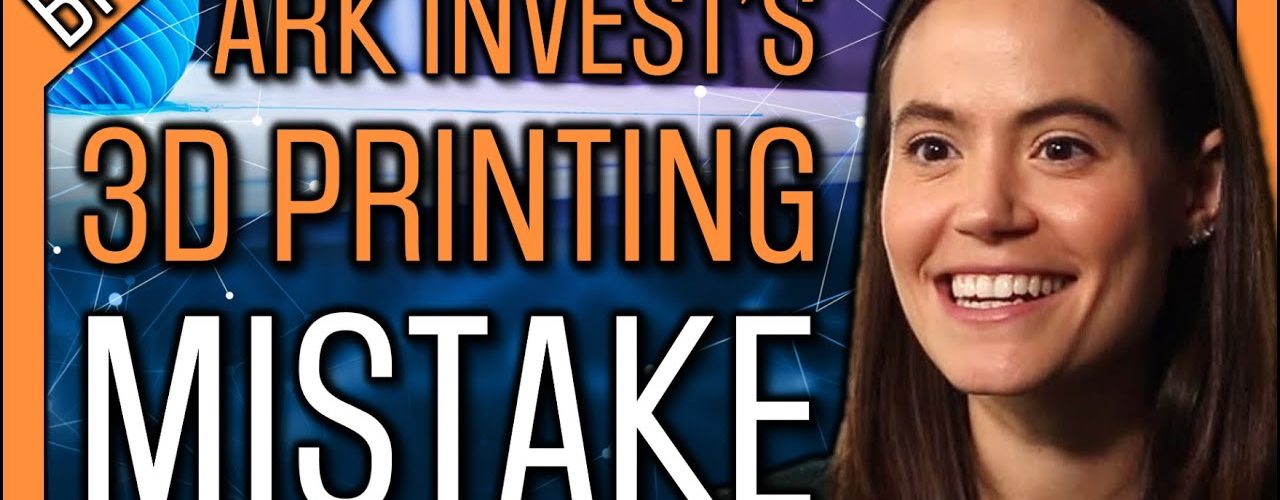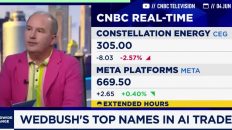Mentioned in Video:
- Why This 3D-Printed House Will Change The World (The B1M): https://www.youtube.com/watch?v=XHSYEH133HA
- 3D-printed homes could lead to a revolution in real estate (CBS News): https://www.youtube.com/watch?v=G_xGPUJ1YoA
- Big Ideas 2019: 3D Printing for End-Use Parts | ARK Invest: https://www.youtube.com/watch?v=C04uRnskeak
- Livewire Markets – The 3D printing boom is coming (with Tasha Keeney of ARK Invest): https://www.youtube.com/watch?v=NufVMirV3SE
- Why ARK Created A 3D Printing Index (Tasha Keeney, ARK Invest): https://ark-invest.com/articles/analyst-research/3d-printing-index/
- Competition Within The 3D Printing Industry is Heating Up: Validating Its Market Potential (Tasha Keeney, ARK Invest): https://ark-invest.com/articles/analyst-research/competition-within-the-3d-printing-industry/
- 3D Printing: Innovation Case Studies (Tasha Keeney, ARK Invest): https://ark-invest.com/articles/analyst-research/3d-printed/
- 3D Printing: The Path to Cheaper, Faster Drug Approval (Tasha Keeney, ARK Invest): https://ark-invest.com/articles/analyst-research/3d-bioprinted-solution/
- Support the channel and get extra member-only benefits by joining us on Patreon: https://www.patreon.com/tickersymbolyou
ARK Invest has prominently featured 3D printing in ARKK, ARKQ, PRNT and mentioned it as an enabling technology ARKX. Cathie Wood has been holding NNDM (Nano Dimension Stock), SSYS (Stratasys), DDD (3D Systems), and more for years while calling for the 3D printing boom since the start of ARK Invest. It's been one of ARK Invest's Big Ideas since they began publishing it! So, uh… where the heck are these things?
Video Transcript:
[00:00:00.000]
When you think about 3D printing, you're probably thinking about this. My hope is to convince you that 3D printing is a much bigger idea, maybe even bigger than ARK Invest gives it credit for. 3D printing isn't any one thing. It's a process. It's about turning your vision into a reality one layer at a time. It doesn't matter how complex or precise or strange the design. There are almost no limits when it comes to materials.
[00:00:26.550]
Which explores how 3D printing is to transform the food industry. Edible growth is about 3D printing with living organisms.
[00:00:34.530]
There are almost no limits when it comes to scale. Don't just think about 3D printed houses. Think about 3D printed communities designed like printed circuit boards. That's the big idea. Because there are almost no limits to the designs or the materials used. There are almost no limits to the 3D printing process. Besides cost, time, and imagination. Hopefully 3D printing is starting to capture your imagination like it has mine. In my opinion, a good imagination is key to developing a vision of the future worth investing in. And as it turns out, 3D printing has has captured the imagination of ARK Invest as well.
[00:01:11.290]
3D printing and automation, which 3D printers definitely fall under, are two of only six Big Ideas that have never dropped from the list. Big Ideas is a publication that ARK Invest releases every year to talk about the groups of technologies they think are going to change the world soon, like starting now soon. For 3D printing. however, ARK Invest has been saying now for years, and for years they've continued to put their money behind their vision of 3D printing through their actively managed thematic ETFs. Here's how I would map their six funds, ARKK, ARKG, ARKW, ARKQ, ARKF and ARKX onto these big ideas.
[00:01:48.600]
3d printing stocks sit inside ARKQ, ARK Invest's fund themed around the autonomous revolution, and I expect to see them in ARKX, ARK Invest's soon to be released fund themed around space exploration. 3d printing stocks also sit inside ARKK, ARK Invest's flagship fund, and they even maintain their own 3d printing index fund, ticker symbol PRNT to track the performance of the industrial 3D printing space as a whole. So let's get a quick overview of this big idea from Tasha Keeney, ARK Invest's analyst focused on autonomous technology and robotics strategy.
[00:02:23.420]
After that, we will hear from Cathie Wood herself. And finally, I'll jump in with my ultimate vision for 3D printing. A big idea that I'm surprised ARK Invest isn't talking about way more often. Let's start with Tasha.
[00:02:35.540]
3D printing is totally revolutionizing manufacturing. With 3D printing complexity is free, so you're allowed to create these structures that you could have never created before with traditional manufacturing. So the interesting thing about 3D printing is a lot of people think the opportunity is over. There was this period in 2014, 2015 where everyone thought there'd be a 3D printer in all of our houses, and that never happened. We don't think it ever will. The real opportunity for 3D printing is industrial use cases.
[00:03:06.810]
3D printing is a form of additive manufacturing, so traditional or subtractive manufacturing you can think of as you have a big block of material and you shave away at it to create your part. 3d printing builds the part from the ground up in a layer by layer process. And when you do that, you get a lot of advantages. One of the biggest ones is you basically eliminate any constraints that you previously had on your design. And in doing that, you can actually now use AI to design the part.
[00:03:36.870]
So you get these parts that a human could have never imagined that could have never been produced before. But you can today, with 3D printing. So this is really disruptive for the health care and aerospace markets. Any market where you have very complex, low volume parts. So for aerospace, you can often save weight in 3D printing and a very small percentage savings in weight. So if you due to the weight of apart by 5%, you could save 20% on fuel burn. So that makes a lot of difference to the margins of these aerospace companies.
[00:04:10.360]
On the health care side, anything that's customized. Basically, you can scan a human body and print out an implant that's designed specifically for the patient. Previously implants, you'd find whatever were the closest fit was, you might actually have to shave away at the patient's bone to make it fit. So you're getting shorter operating times and better patient outcomes with this technology.
[00:04:33.430]
So because 3D printing let us build things layer by layer, it allows for amazing one part designs that could never be possible when you make something from a mold or by cutting it out of a larger block. 3d printing reduces labor costs, part counts, risks of failure, weight, complexity and material waste. And ARK Invest has been calling this out for years. So where the heck are these things? Here's Cathie Wood explaining what's happening with 3D printing during her recent interview on ETF Trends with Tom Lydon, focusing on 2021's Big ideas.
[00:05:07.210]
3D printing, true Valley of Despair category. We've been pounding the table on this for a long time. And of course, the dagger in it this year or last year was the Coronavirus and that hit aerospace autos. But particularly aerospace, the killer app for 3D printing harder than almost any space. And yet today I think I saw in one of the it might have been the GE report that planes are retiring at such a fast rate that the pace of airline deliveries is now outpacing the retirements.
[00:05:48.600]
So that's good news. And it's good news for 3D printing. We do believe this market is going to scale at a 60% annualized rate during the next five years. We have been saying this for quite some time, and one thing after another has derailed it. The aerospace companies have gross margins in the 15% to 20% range. They're much lower this year, of course, but normalized. And so they have every incentive now to accelerate the use case for 3D printing on their planes. And we think that's going to be one of the largest opportunities.
[00:06:24.940]
We always look for new ideas during the Valley of Despair. And so, you'll see, we increased our exposure to 3D printing in the last year. I just saw a report, Cathie, on 3D printed houses. Yes. China has been fast forwarding on that one. Yes, absolutely. They're tiny, but they're happening, and they're very expensive. They're prototypical right now. But that gives you a sense of where this is going. It's going to be ubiquitous as we bring the cost down and as the technology becomes more sophisticated.
[00:07:08.070]
Whoa. Let's back up a second. Yep. Right there. Zoom, enhance. Okay. Aerospace and automobiles because you're reducing parts, weight and steps during production, machinery makes sense because you can 3D print new types of tools, molds and structural components. And 3D printing for healthcare enables the production of custom fit, surgical implants, medical devices and personal protective equipment. Where the heck is housing? No, seriously, where the heck are all the houses? There's a massive shortage of homes for sale today. Since this time last year, there's a record 44% less homes for sale in rural areas, 38% less in suburban areas and 17% less in urban areas. Combined,
[00:07:52.100]
this is a 34% decrease in housing availability. The median sale price for a house is up an average of 15% from just one year ago, 15 in a matter of months. That's a massive rally. And the median time a house stays on the market was cut by about 40%, which means the average home is selling in one month instead of about two, even at these 15% higher prices. And just to be clear, these stats account for the fact that homes have been getting bigger in general.
[00:08:20.980]
The price per square foot is also up about 15% year over year. This is what current headlines mean when they talk about the affordable housing crisis. Hopefully, I've proven to you that there is a real quantifiable problem in the real estate market right now. Or said another way, real estate is ready for disruption.
[00:08:40.130]
This ordinary looking home could lead to a revolution in real estate, not in the design, but how it was built.
[00:08:48.010]
You are sitting in a 3D printed, 1900 square foot structure.
[00:08:51.530]
Kirk Anderson of construction tech company SQ4D showed us this Long Island model home that was made with a 3D printer.
[00:08:59.800]
We should be able to do our part of the build in about eight days or less.
[00:09:03.100]
So what does it mean to print a house? Well, a robot stacks layers upon layers of concrete, literally building from the ground up. SQ4D is constructing a similar residence nearby that's already for sale. The three bedroom, 1400 square foot house is listed for $299,000. Homes of comparable size in the area come with a price tag around 100,000 higher and often much more. Of course, the printer can't do all the work. It can build about 40% of the structure, and then workers have to do the rest.
[00:09:36.360]
But even that 40% can drastically lower construction costs.
[00:09:40.700]
This process can save you about 20% to 30% on an overall build.
[00:09:44.670]
Other home builders are using 3D printers as well. The company Icon in Texas works with nonprofits to provide low income housing. Mighty Buildings in California offers homes that range from Studios to three bedrooms, the company's cofounder says doing it in a warehouse gives them flexibility.
[00:10:02.300]
We've developed a unique technology. We can print unique geometries, we can do curves, we can do free form.
[00:10:07.600]
SQ4D claims they've already received more than 1000 offers to purchase the home, a possible indication consumers are ready to accept this new dimension in construction.
[00:10:18.670]
Cathie Wood often says that during times of turmoil, businesses are more likely to try new ways to solve their challenges. Innovation thrives when more people are willing to adopt new technology. In my opinion, that's true of individuals as well. A 20% to 30% cost reduction for a home is nothing to sneeze at. But like every other disruptive technology, that number is just the beginning. Listen to this next clip from the B1M's video titled “Why this 3D Printed House Will Change the World”. In it, Peri, the company behind the first fully permitted and certified 3D printed building in Germany, talks about their integrated planning process before printing the structure of the house and what had saved them
[00:10:58.960]
in terms of labor costs, onsite mistakes, and material waste.
[00:11:02.940]
Peri also engaged them about the core traits on these projects, a critical hurdle that few other 3D printed buildings have attempted to cross. With services and other works already coordinated with the Structural Design, errors on site have been almost completely eradicated, saving time, money and waste material. While the savings may be modest here, they'd soon add up across the entire state or housing developments.
[00:11:29.880]
What kind of real world savings have you seen on this project so far?
[00:11:33.930]
There's really this integration of other traits has a huge impact. So we've had the electrician to come into one of these buildings, and he walks around and says, Well, guys, I'll be saving up to, like, twelve days in here. So we are saving a lot of labor in other traits, because in the building to executing, there's not going to be a single slot that has to be cut. Nobody's going to have to drill a hole for a power outlet.
[00:12:00.750]
Though the design of these buildings may feel relatively straightforward when compared to some today's architecture, the team are using the lessons learned to construct larger structures in a variety of forms. With German building certifications now under their belt, the team are planning more projects using different materials and with a focus on further reducing waste.
[00:12:20.220]
That last part, adding up savings across entire housing developments is my ultimate vision for 3D printing. Here's what that could look like, a whole community can be planned out beforehand and designed in a scalable way so more homes can be added down the road. It can also be designed in a way that minimizes the expensive infrastructure involved, the amount of pipes and lines that run beneath the ground, just as one example. This means that you can design a 3D printing template for an entire community, not just individual buildings, providing a whole new level of cost savings, savings based on the reduced labor and material waste for each building individually, and savings based on optimizing the design of the community and its infrastructure as a whole, while benefiting from economies of scale.
[00:13:07.400]
By the way, this could also be how we do it on Mars. That's the big idea. Don't believe me? Dubai wants to 3D print 25% of every new building by 2025, not just the structures of the buildings themselves. The plan is to start small: doorknobs hinges, door and window frames, railings for stairs and balconies, benches, and so on, before moving on to more elaborate assemblies like sinks and tubs, office desks and cabinets. And that's the last piece of the puzzle. In my opinion, mass adoption of this big idea will come from companies 3D printing all of the little widgets in our homes and offices today.
[00:13:46.840]
As we all get more exposure to 3D printing by virtue of owning and using more 3D printed products in our everyday lives, demand will naturally continue to rise and supply will rise to meet it, lowering overall 3D printing costs in the process thanks to Wright's Law. And as the technology matures, the size and scope of the parts that get 3D printed will go up. In addition, the amount of a building's structure and infrastructure that gets 3D printed will go up exponentially as cost due to labor and wasted material continue to go down.
[00:14:18.430]
The bigger the building, the more impact to the bottom line this will have, slowly forcing commercial construction companies to incorporate this new building process or be disrupted by the ones that do. And finally, all of those 3D printing processes will make their way into the residential sector, sometimes one building at a time, and sometimes by printing entire communities. And of course, all of the other great applications that ARK invest has been pounding the table on for years: aerospace, auto, healthcare, biomaterials, semiconductors, and beyond. When it comes to 3D printing, the only limits are costs, time, and whatever designs you can dream up.
[00:14:58.850]
And in my opinion, ARK Invest's only mistake on 3D printing is not dreaming big enough. This is Ticker Symbol: You. My name is Alex, reminding you that the best investment you can make is in you.
If you want to comment on this, please do so on the YouTube Video Here














